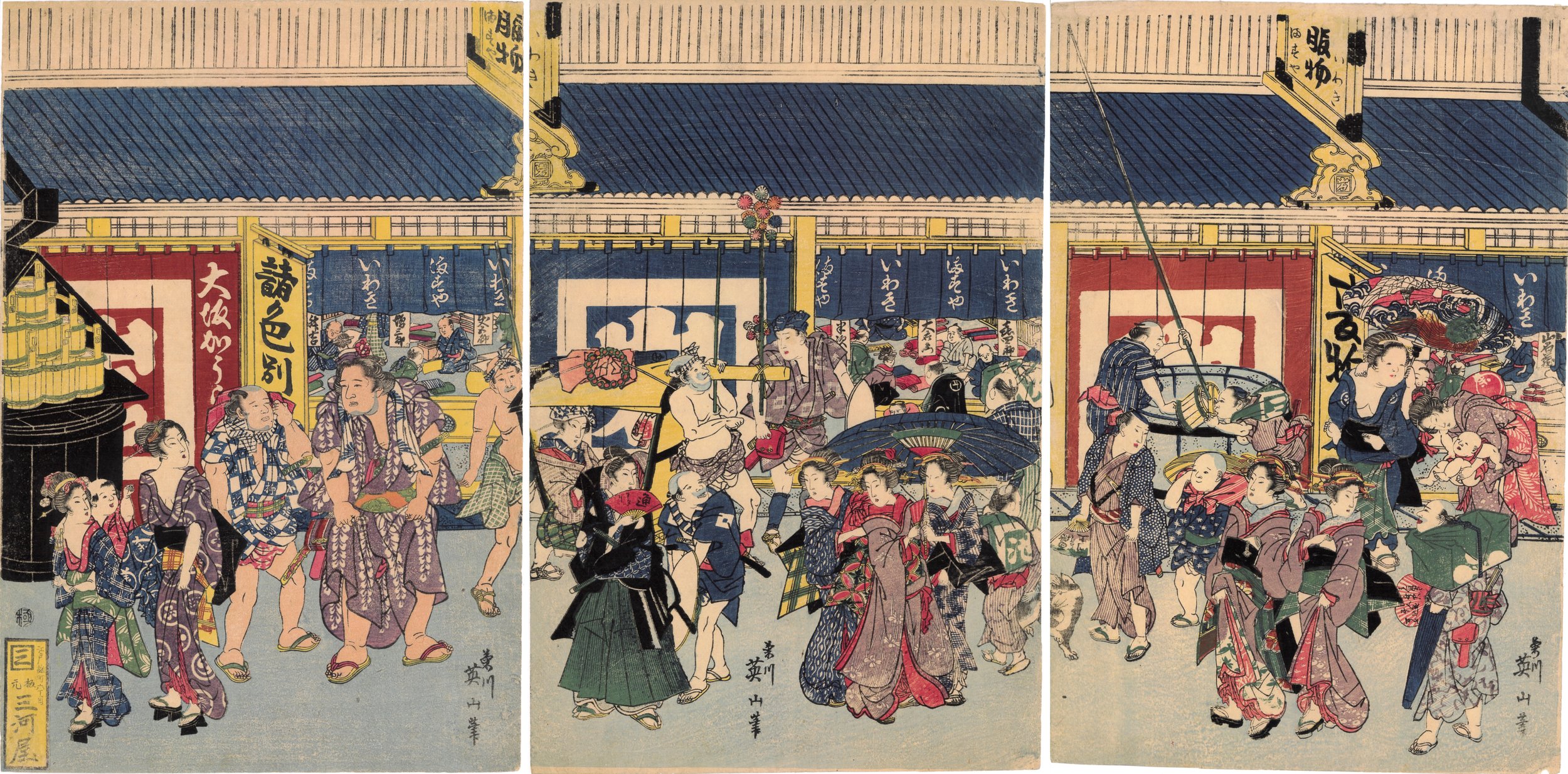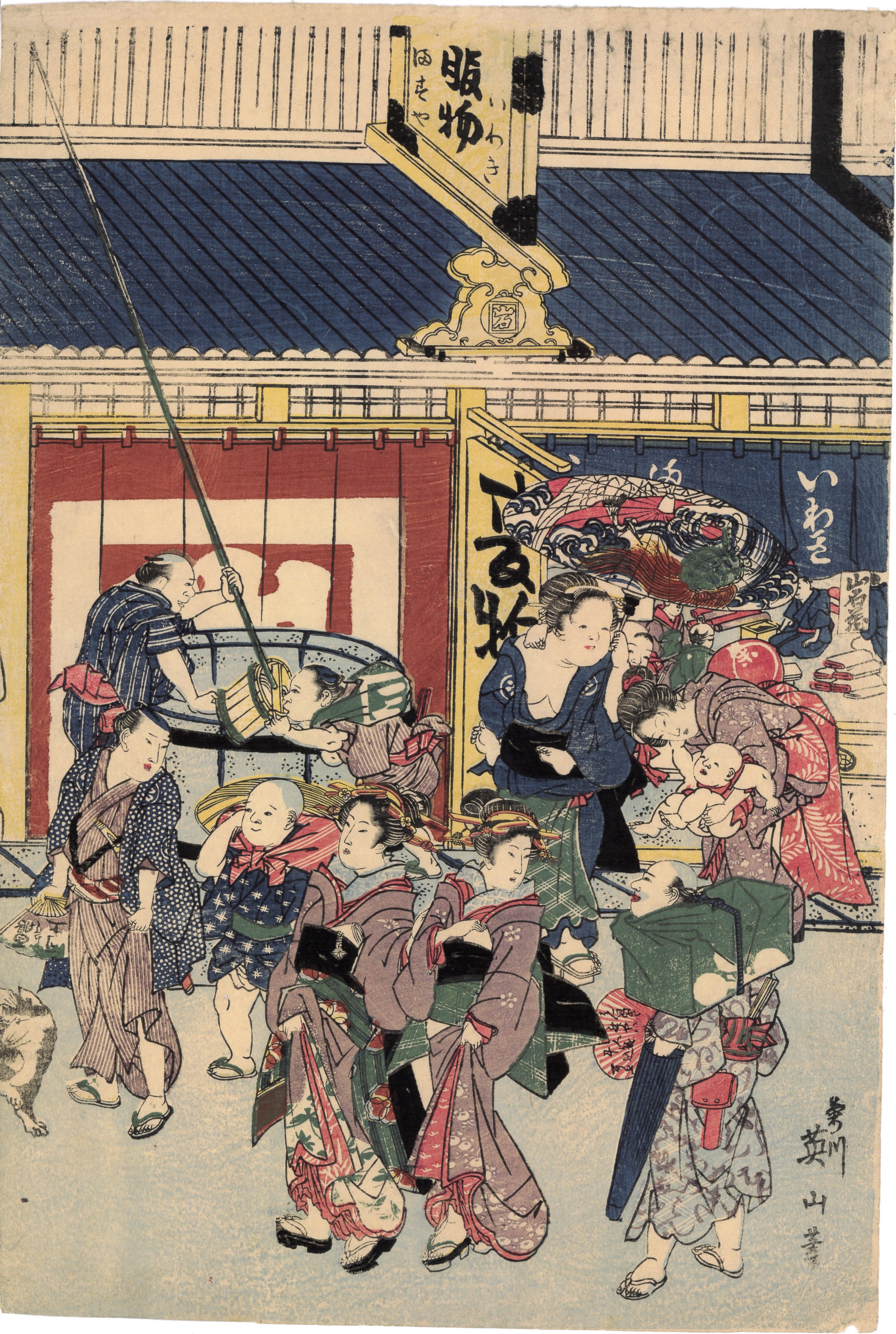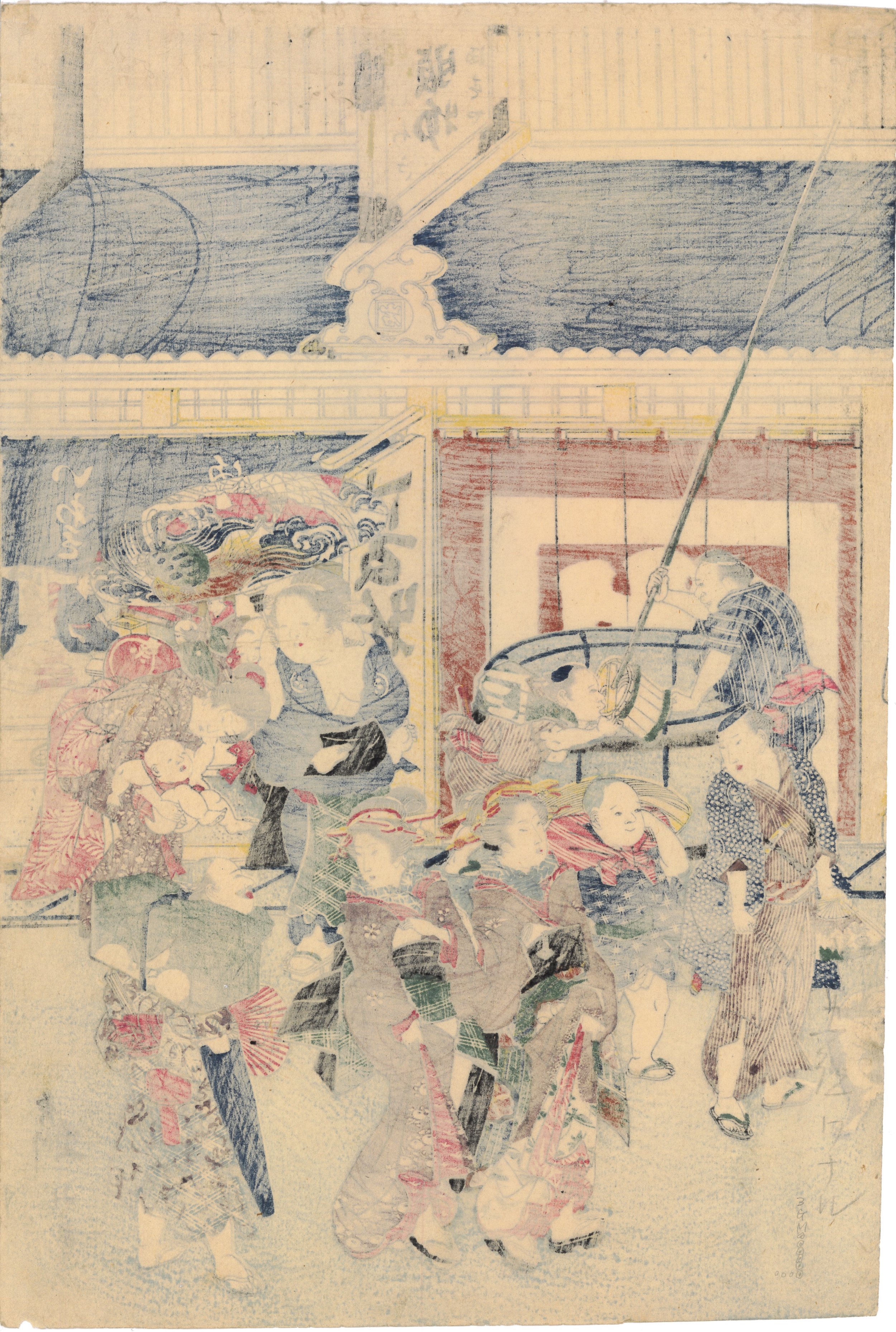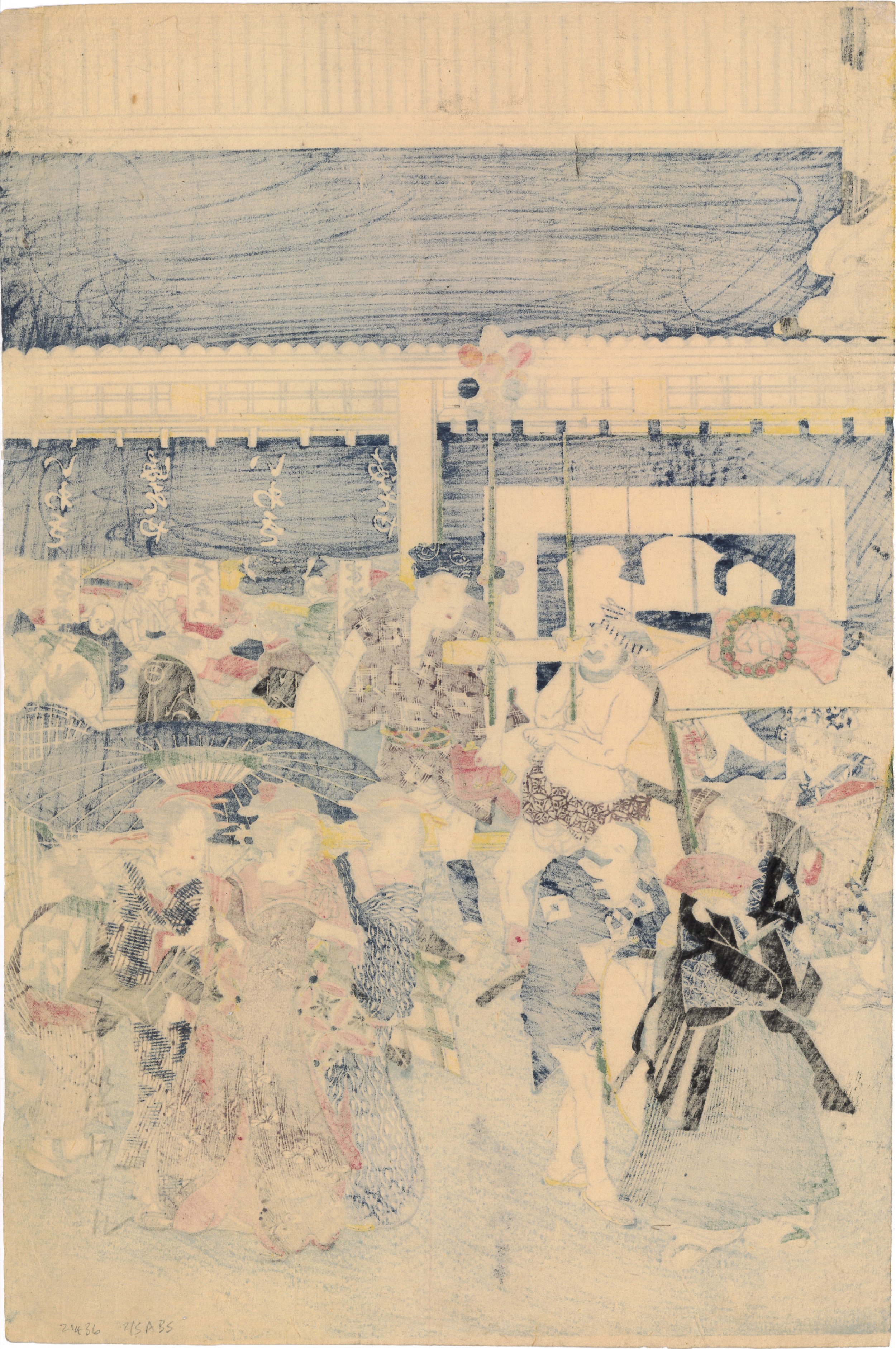菊川英山 Kikukawa Eizan(1787-1867)
岩城舛屋前的热闹景象
Bustle of People in Front of Iwaki-Masuya Store
1815
木版画 | 三联续绘-纵绘大判 | 39cm x 25.8cm x 3
Woodblock-print | Triptych Oban tate-e triptych | 39cm x 25.8cm x 3
早期版次;颜色鲜艳;品相非常好
Fine impression, color and condition.
$9,500
岩城舛屋,始创于江户时代京都,是当时极具规模的和服商。全盛时期,其店铺遍布江户、京都、大阪三都,仅大阪分号就有三百多名员工,堪称和服界的“扛把子”。
江户时代市民经济蓬勃发展,商家为了扩大知名度,各出奇招,浮世绘便成了最吸睛的宣传媒介之一。像岩城舛屋这样的大店,自然少不了借助画师之笔。而英山的美人画,本就与绚丽和服相得益彰——在这幅作品中,他更大胆采用了超前的构图设计,将画面三分之一留给屋檐与招牌构成的极简几何线条,反衬出店前人群的热闹非凡。
一时间,江户众生相跃然纸上: 身高体壮的相扑力士正与他的随从低语; 两名哼哧哼哧的光膀子轿夫抬着轿笼里的大小姐穿行闹市; 俊美的青年武士与三位美人儿对上了眼,折扇轻摇间情愫暗生; 背着行囊的客商,也对路过的艺伎露出了谄媚的微笑; 只有水井旁的那个赶路人无暇他顾,一心端起水桶牛饮。
画中人物神态各异,生动有趣。不同风格的和服也在画中被自然展示,让观者在欣赏画面的同时,潜移默化地将服饰与岩城舛屋联系起来。英山这番巧妙的视觉策略,即使放在今天,也是广告人值得借鉴的案例。
本作保存状态极佳,木纹清晰,色彩明丽,即使是最易褪淡的紫色亦鲜艳如初,实为难得。
Iwaki-Masuya was a superstore of its time, taking up practically a whole block and employing as many as 500 people. While it had many goods to offer, it specialized in silk and fabrics and was patronized by the top strata of Edo society.
Here, in this rare and ahead-of-its-time design by Kikukawa Eizan, we see the store’s signage and facade depicted in all their geometric glory. Its entrance curtains emblazoned with the store’s logo would be instantly recognizable to print buyers of the time.
But what’s really interesting is the bustling cross-section of Edoites the triptych captures: a pair of courtesans being approached by a merchant, his wares on his back; a trio of women beneath an umbrella flirting with a samurai; two grunting palanquin bearers and their female charge; a mother and her baby; a thirsty worker enjoying a cool drink of water from a well; a sumo wrestler and his attendant, all out and about on a stiflingly hot day in what was then the largest city in the world.
Eizan was known for his willowy portrayals of beautiful women (bijin) with a stylistic debt to Utamaro. That’s what makes this design so fascinating – it was an unusual choice for him, even if it is filled with the beautiful women with intricate kimonos for which he was known. Hiroshige would do a similar treatment of this store – but not for 35 years.
This example is in remarkably good condition, with sharp registration and strong colors (including first-to-fade purple).
Interested in purchasing?
Please contact us.
菊川英山 Kikukawa Eizan(1787-1867)
岩城舛屋前的热闹景象
Bustle of People in Front of Iwaki-Masuya Store
1815
木版画 | 三联续绘-纵绘大判 | 39cm x 25.8cm x 3
Woodblock-print | Triptych Oban tate-e triptych | 39cm x 25.8cm x 3
早期版次;颜色鲜艳;品相非常好
Fine impression, color and condition.
$9,500
岩城舛屋,始创于江户时代京都,是当时极具规模的和服商。全盛时期,其店铺遍布江户、京都、大阪三都,仅大阪分号就有三百多名员工,堪称和服界的“扛把子”。
江户时代市民经济蓬勃发展,商家为了扩大知名度,各出奇招,浮世绘便成了最吸睛的宣传媒介之一。像岩城舛屋这样的大店,自然少不了借助画师之笔。而英山的美人画,本就与绚丽和服相得益彰——在这幅作品中,他更大胆采用了超前的构图设计,将画面三分之一留给屋檐与招牌构成的极简几何线条,反衬出店前人群的热闹非凡。
一时间,江户众生相跃然纸上: 身高体壮的相扑力士正与他的随从低语; 两名哼哧哼哧的光膀子轿夫抬着轿笼里的大小姐穿行闹市; 俊美的青年武士与三位美人儿对上了眼,折扇轻摇间情愫暗生; 背着行囊的客商,也对路过的艺伎露出了谄媚的微笑; 只有水井旁的那个赶路人无暇他顾,一心端起水桶牛饮。
画中人物神态各异,生动有趣。不同风格的和服也在画中被自然展示,让观者在欣赏画面的同时,潜移默化地将服饰与岩城舛屋联系起来。英山这番巧妙的视觉策略,即使放在今天,也是广告人值得借鉴的案例。
本作保存状态极佳,木纹清晰,色彩明丽,即使是最易褪淡的紫色亦鲜艳如初,实为难得。
Iwaki-Masuya was a superstore of its time, taking up practically a whole block and employing as many as 500 people. While it had many goods to offer, it specialized in silk and fabrics and was patronized by the top strata of Edo society.
Here, in this rare and ahead-of-its-time design by Kikukawa Eizan, we see the store’s signage and facade depicted in all their geometric glory. Its entrance curtains emblazoned with the store’s logo would be instantly recognizable to print buyers of the time.
But what’s really interesting is the bustling cross-section of Edoites the triptych captures: a pair of courtesans being approached by a merchant, his wares on his back; a trio of women beneath an umbrella flirting with a samurai; two grunting palanquin bearers and their female charge; a mother and her baby; a thirsty worker enjoying a cool drink of water from a well; a sumo wrestler and his attendant, all out and about on a stiflingly hot day in what was then the largest city in the world.
Eizan was known for his willowy portrayals of beautiful women (bijin) with a stylistic debt to Utamaro. That’s what makes this design so fascinating – it was an unusual choice for him, even if it is filled with the beautiful women with intricate kimonos for which he was known. Hiroshige would do a similar treatment of this store – but not for 35 years.
This example is in remarkably good condition, with sharp registration and strong colors (including first-to-fade purple).
Interested in purchasing?
Please contact us.








